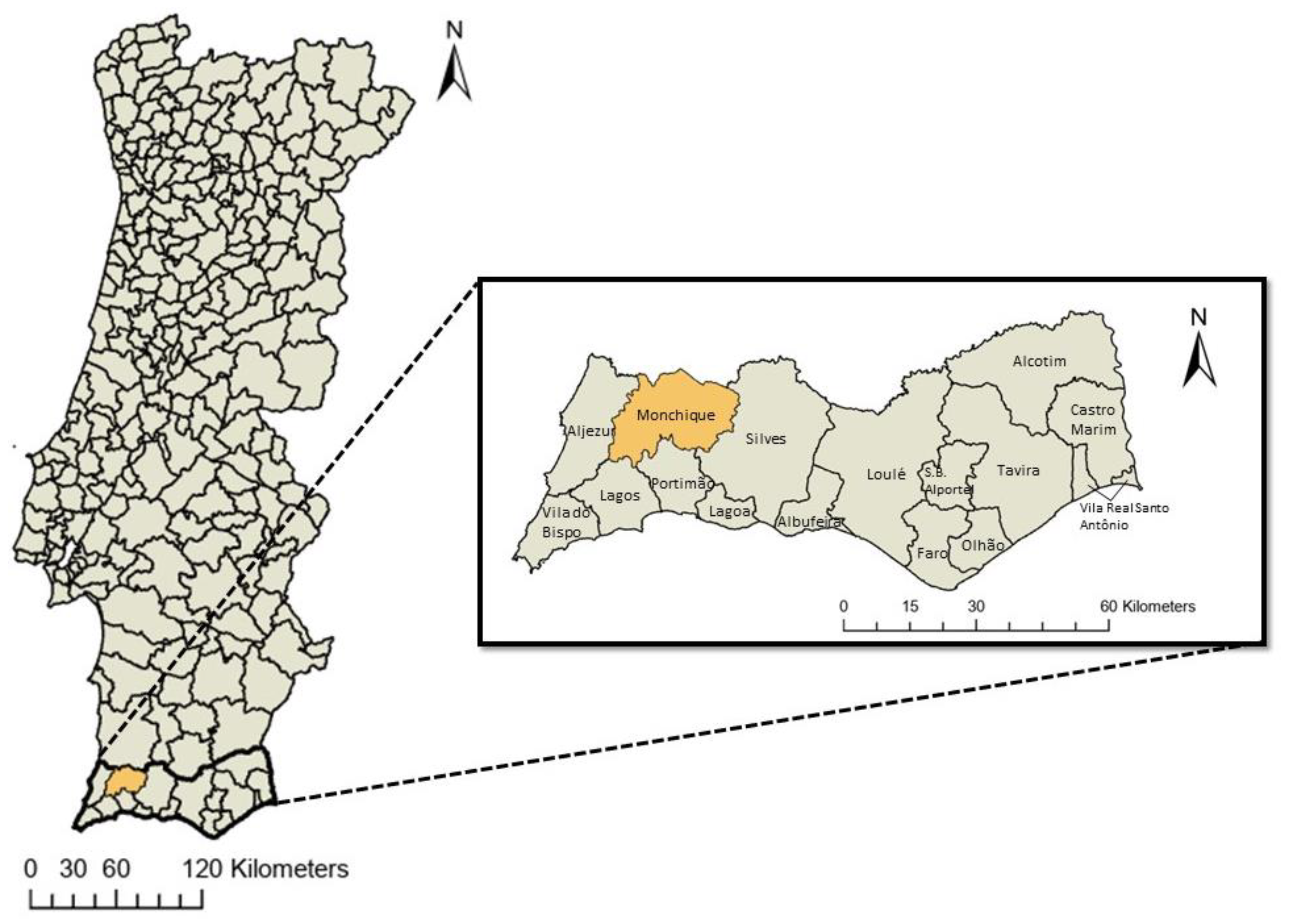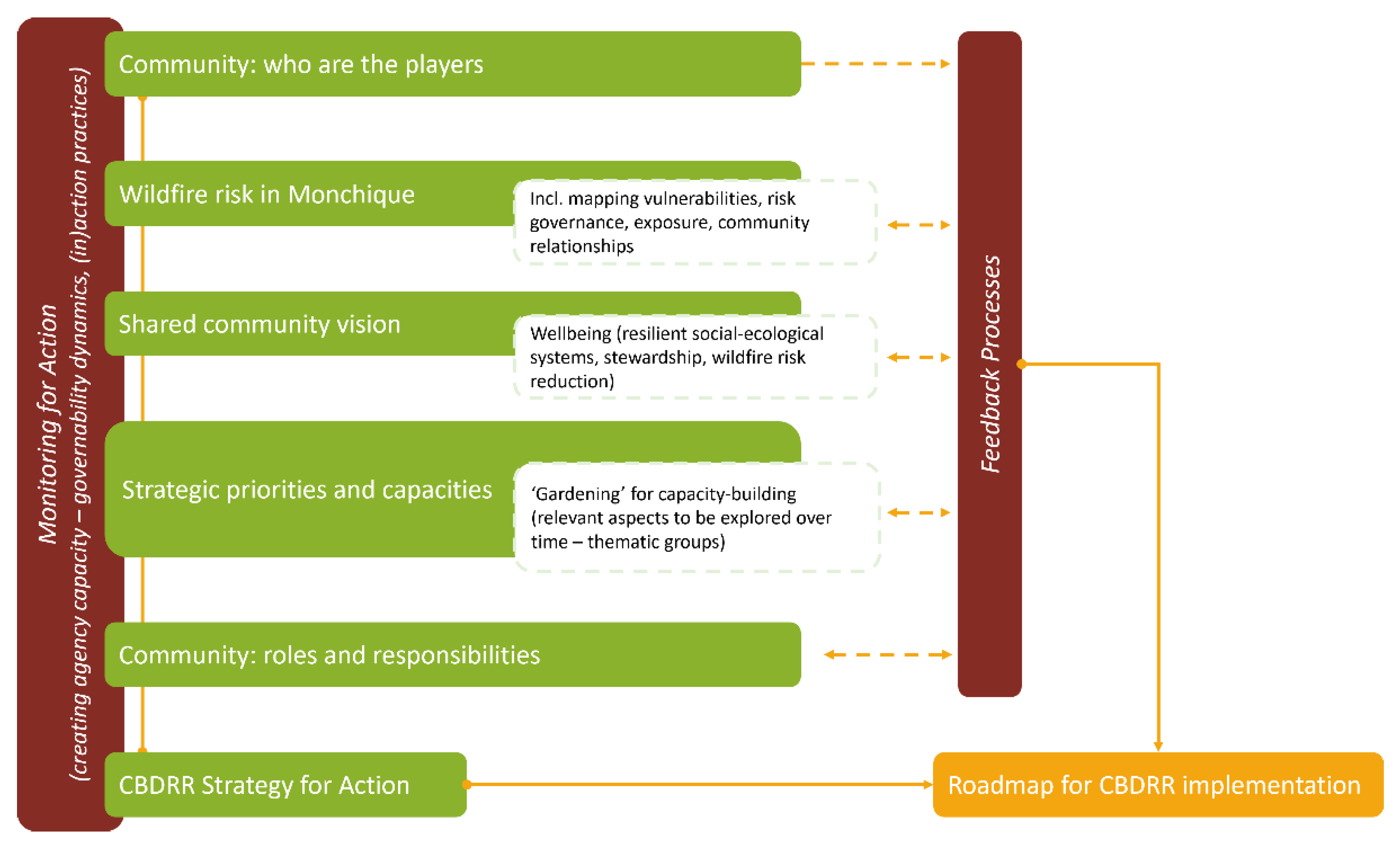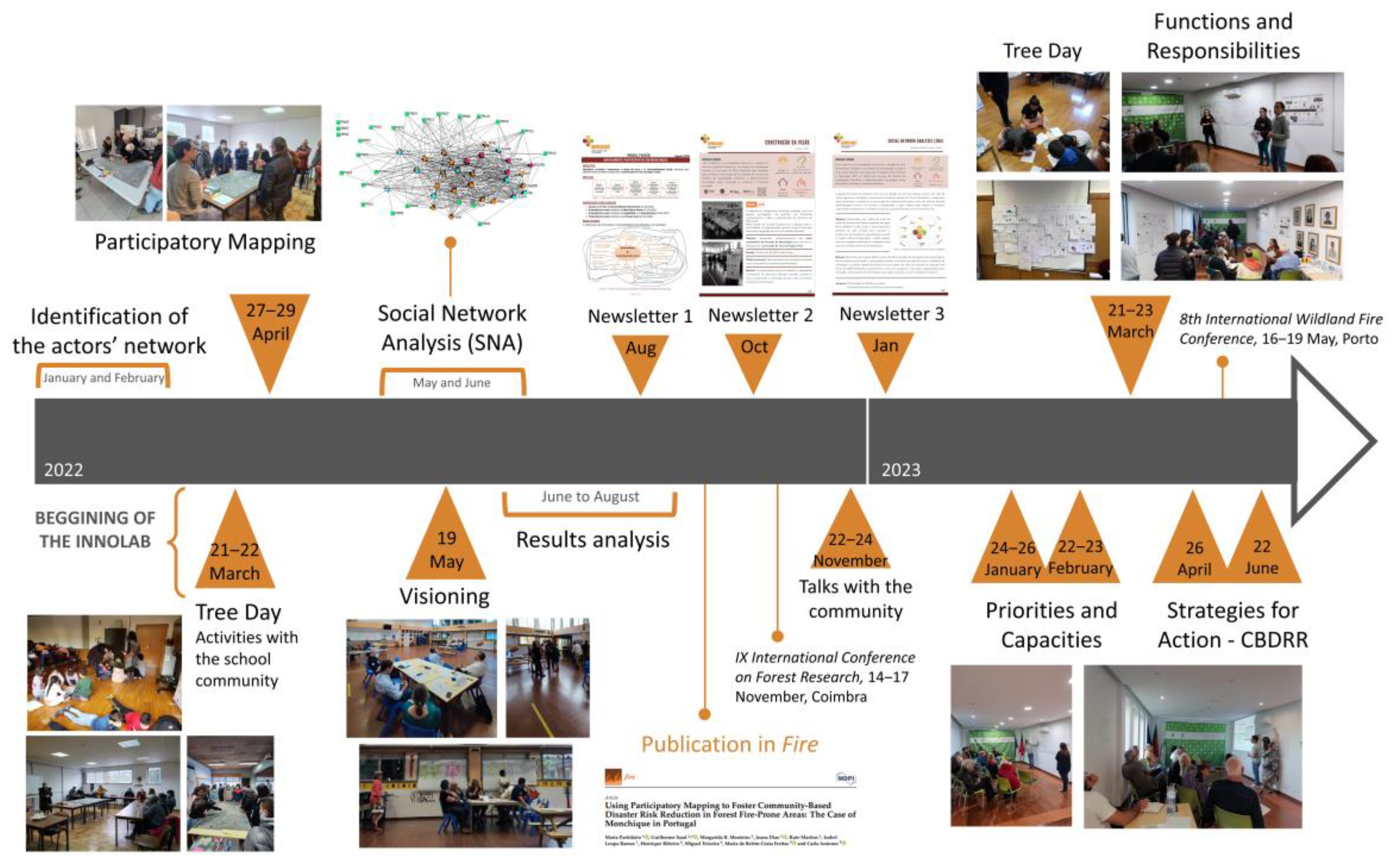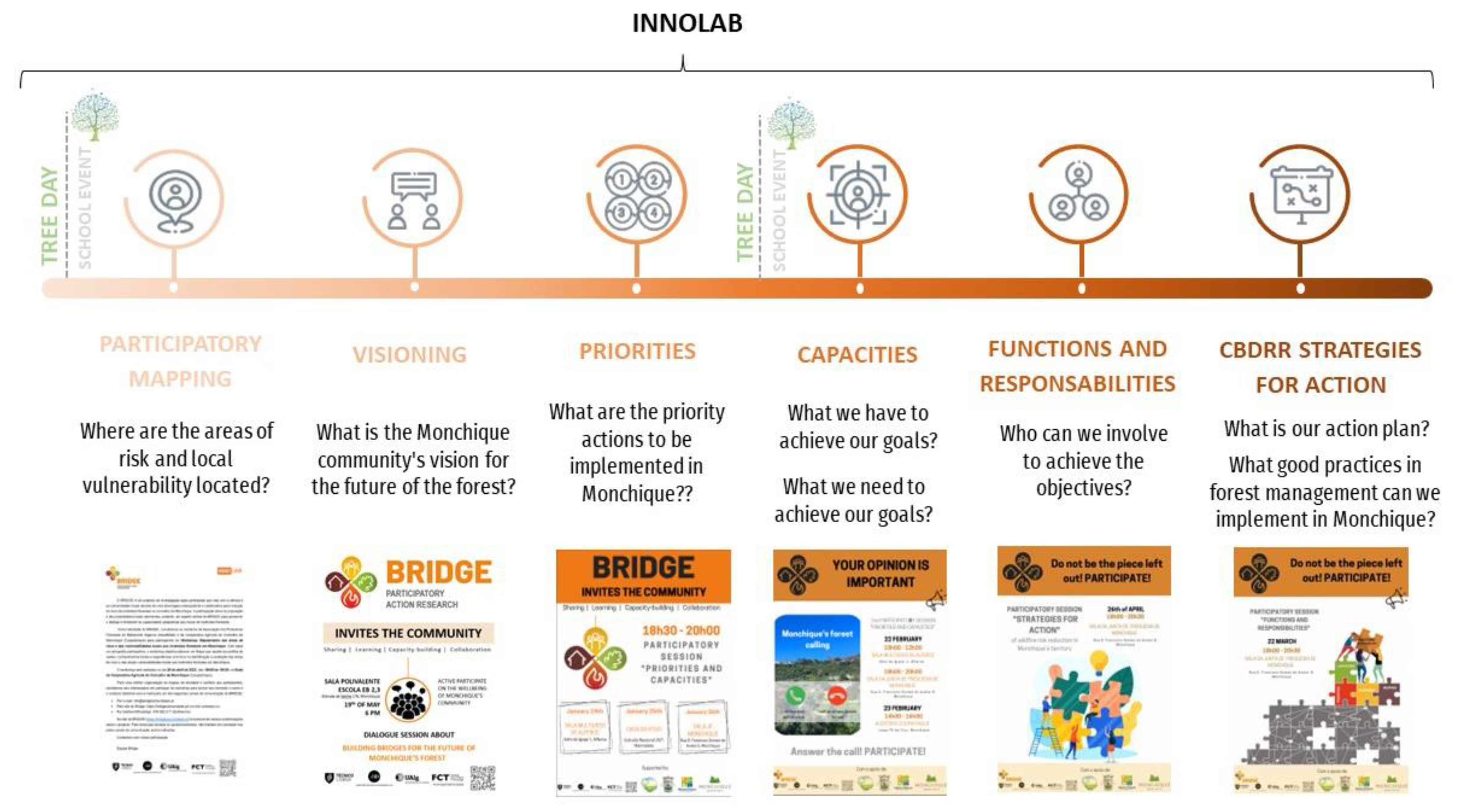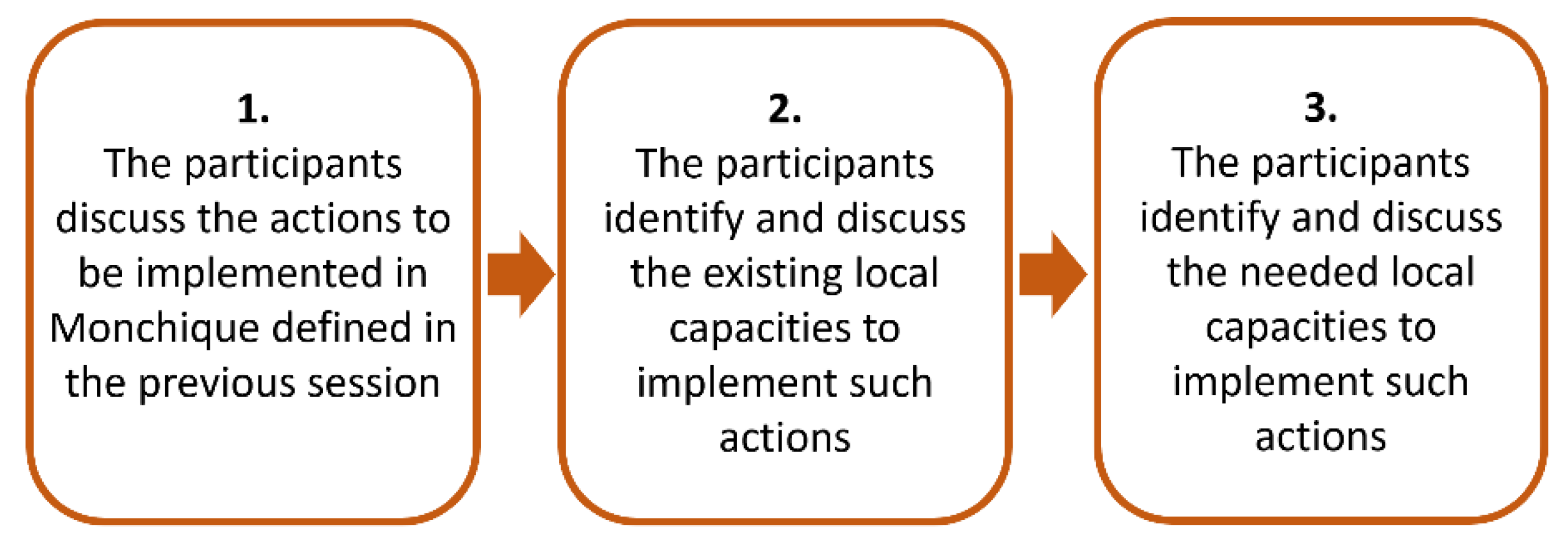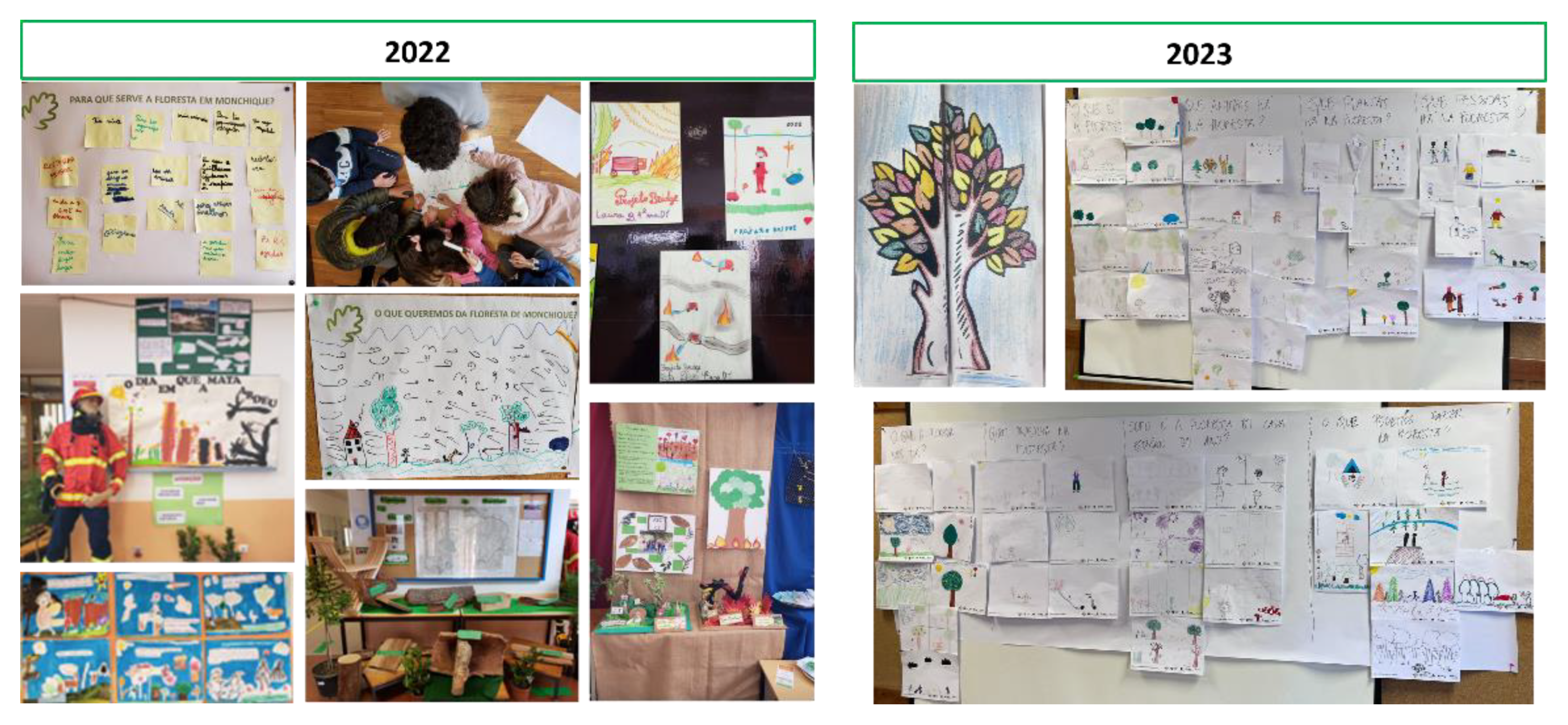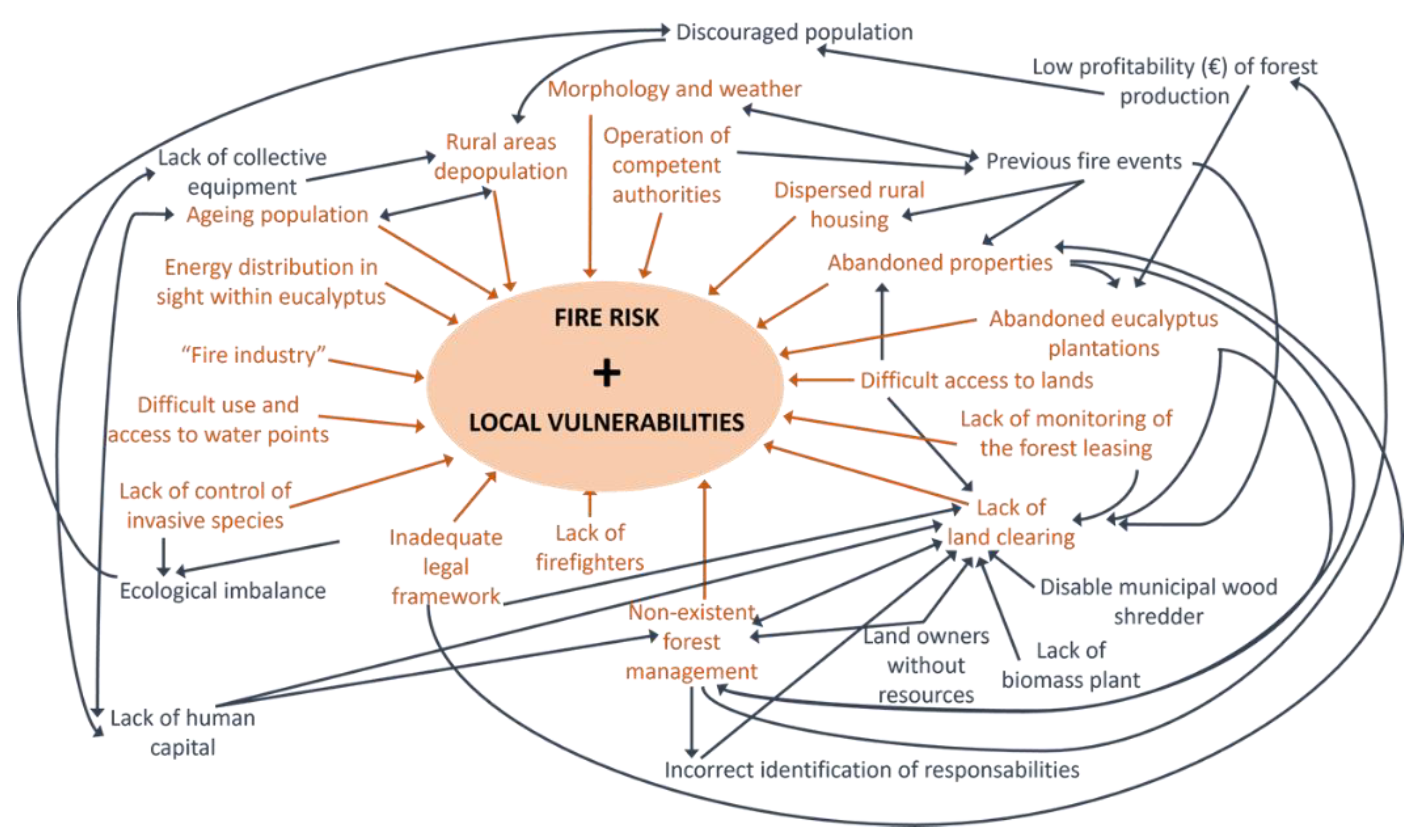1. Introduction
The occurrence of forest fire events is becoming more frequent on our planet, affecting more people and generating devastating social, environmental and economic impacts. These wildland fires are a global disaster phenomenon occurring worldwide, and have been increasing in number, area, and intensity, as a result of climate change, territorial disorder, and lack of forest management, while also impacting communities and ecosystems that are exposed to risk areas [
1]. Thus, wildfires (non-natural and non-prescribe) represent a major challenge being faced when sustainably managing forest territories in Europe, as pointed out by the EU’s new Forest Strategy for 2030 [
2].
The forest research field has been increasingly focusing on disaster-related topics, with the scientific literature emphasising that local experiences, knowledge, and practices are central aspects in reducing the risk of wildfires, highlighting the need for recognising local systems of knowledge and fostering the active role of forest communities in forest fire risk management [
3,
4,
5]. The literature also highlights the community-based disaster risk reduction (CBDRR) participatory process approach as a way to place communities living in risk areas at the centre of disaster risk reduction. This occurs by collectively encouraging them to take an active role in the identification, analysis, and management of (wildfire) disaster risks [
6].
Aligned with that stream of community-based research, Gaillard and Mercer (2013) emphasize the need for integrative processes that consider both bottom-up and top-down actions [
7]. Several other authors, also highlight the need for involving scientific and local knowledge as well as a broad spectrum of key actors and stakeholders [
7,
8,
9]. Silva et al. (2010) also state that all stakeholders engaged in different territorial management scenarios (including forest communities) need to have the opportunity to participate in the distinct stages of forest fire management [
10] Thus, in the CBDRR approach, the adoption of participatory processes is essential to engage forest communities living in risk areas and strengthen their adaptive capacities [
11]; this contributes to increased local resilience of forest territories by using knowledge, resources available in the territories, and skills from communities relating to the treatment of fuels, to help towards an adaptive management of disaster risks [
12].
Twigg (2015) highlights that the use of participatory methodologies may provide insights into how and why conflict between stakeholders may arise, while at the same time it may promote collaboration and dialogue between them [
13]. The development of social learning and the empowerment of communities is pointed out as a consequence of increasing participatory moments [
14,
15,
16]. Moreover, the European Commission (2023) has been supporting the development of research on participatory fire-management strategies to strengthen forest-fire-prone territories through the integration of know-how from experts and local people in order to protect (and enhance) social and ecological ecosystem functions [
17].
Participatory approaches can thus contribute to increased levels of stakeholder involvement, namely through the following: (i) creation of a systemic view of the picture under analysis; (ii) definitions of solutions adapted to local contexts; (iii) promotion of social equity; (iv) increase of trust among the key agents involved; and (v) increasing the legitimacy of the decision-making process and of the levels of its implementation [
14]. Additionally, such participatory moments may be key in building individual and collective capacities for those who engage in them [
18], namely capacities to reduce exposure and sensitivity to shocks and pressures through preventative measures and useful coping mechanisms towards fire events [
19].
However, as pointed out by Nail (2008), this is not a straightforward process with it being a challenge to reconcile different actors’ agendas with local and scientific knowledge as well as the assumptions and biases from each of these. Thus, public engagement requires constant reinvention and adaptation to time, place, goal and audience, among other issues [
20]. It is also important to emphasize that if such moments have a low participation level, they might not allow for the creation of a voice in the decision-making process, leading to a frustrated, unfulfilled and demoralized citizenry [
21].
Thus, the scientific literature recognises the importance of local knowledge and the active role of forest communities in broadening and strengthening adaptive capacities to forest fire risk. Nonetheless, Vigna et al. (2021) indicates that participatory approaches in forest fire research still seem to be neglected and, therefore, it needs to be further developed to make community involvement in fire-risk areas a central (and non-negligible) aspect of forest fire risk reduction [
5]. Moreover, the literature shows that there is a lack of innovative participatory approaches recognising local knowledge and engaging communities in fire-prone areas integrated into the CBDRR process [
22].
Our aim with this paper is to share an innovative participatory approach in terms of strengthening the ability of individuals, communities, and institutions to collaborate for disaster risk-reduction, and to increase their learning capacities for resilience building and empowerment. This participatory approach has been developed within a CBDRR process and through a collaborative innovation laboratory (InnoLab); it is a space for dialogue and knowledge sharing between multiple actors that, directly or indirectly, manage forest territories. The InnoLab has been implemented within a Portuguese action–research project known as BRIDGE (Bridging science and local communities for wildfire risk reduction).
We will also share lessons on the InnoLab application and its attempts to facilitate social learning about forest fire risks, strengthen collaborative networks and enhance adaptive capacities (socially and institutionally) for forest fire prevention. Insights on how the different actors perceive their territory and how they can build local capacities towards a more enduring commitment to forest fire risk reduction policy are presented.
1.1. BRIDGE Project
BRIDGE (bridging science and local communities for forest fire risk reduction) is a research project (for more information on the project please check:
https://bridgecomunidade.pt/, accessed on 2 December 2023) funded by the Portuguese Foundation for Science and Technology (PCIF/AGT/0072/2019) within the scope of a national call for research projects regarding forest fires’ fight and prevention. The project has been carried out by a consortium coordinated by the Instituto Superior Técnico, from the University of Lisbon, and includes as partners the National Laboratory for Civil Engineering and the University of Algarve. The project is applied in Monchique, a forest-fire-prone municipality in Portugal.
Starting from an anticipatory approach, BRIDGE focuses on prevention and mitigation of forest fires, making use of the traditional knowledge that local communities have about Monchique territory’s strengths and weaknesses, and adequate behaviours towards risk reduction. The BRIDGE project started in 2021 with the aim to interconnect and integrate local and scientific knowledge, encourage local, collective, and preventive agencies, and strengthen adaptive capacity with a focus on forest fire risk reduction strategies using a CBDRR perspective.
The project has been structured around three main tasks (
Figure 1) and Monchique’s municipality, in the region of Algarve in the south of Portugal, acts as the pilot case due to its distinct morphological characteristics and fire-prone areas.
BRIDGE’s first task aimed to understand the pilot case territory and its population, providing a characterization of Monchique’s social–ecological system as well as identifying and assessing the territory vulnerabilities and local strategies towards forest fire risk adaptation.
The second task, what this paper focuses and shares results on, puts forward the InnoLab which aimed to foster dialogue between the local community, the scientific arena and the organisations involved in the management of forest fire risk. The InnoLab (and therefore task two) served as a collective space for Monchique’s related actors (local community, science and organizations) to have dialogue, share knowledge and collectively debate the territory forest fire risk management.
Task three, currently undergoing, aims to share the knowledge collected throughout tasks one and two as well as to disseminate the BRIDGE approach towards building local capacity buildings towards forest fire risk reduction. This task also intends to share BRIDGE experiences and encourage the replication of its approach in other territories that are vulnerable to forest fires.
1.2. Pilot Case
Monchique’s municipality is located in the Algarve region, southern Portugal (
Figure 2). Monchique is part of the district of Faro and is sub-divided into three parishes, Monchique, Marmelete and Alferce. Positioned between Odemira, Silves, Portimão, Lagos, and Aljezur, Monchique has grappled with recurrent forest fires, notably a severe one in 2018 resulting in a burnt area of 271.54 km
2 mostly in the Monchique municipality.
With a total area of 395.30 km2, Monchique’s land use predominantly comprises forestry (66%) and bushes (26%), while artificial lands constitute only 0.7%, primarily in the urban centre of the Monchique parish. The built structure aligns with the main accessibility routes, and agriculture confined to terrace fields occupies less than 5% of the territory.
The region is characterized by a mountainous landscape, with Picota (773 m) in the east and Fóia (902 m) in the west, and the highest point in the Algarve. Over 80% of Monchique’s territory has slopes exceeding 15%, impacting land use, particularly in agriculture. The topography, combined with specific meteorological conditions and vegetation characteristics, contributes to the susceptibility to severe forest fires. This assertion is corroborated by the structural fire risk chart formulated by ICNF (the National Institute of Nature and Forest Conservation), designating Monchique as a priority intervention area due to its elevated susceptibility to forest fires within the socio-economic and socio-ecological framework of fire risk.
The municipality of Monchique has experienced a significant and continuous de-cline in its resident population, losing more than 60% of inhabitants from 1960 to 2021 [
23]. Notably, between 2011 and 2021 alone, a nearly 10% decrease occurred, which contrasts with the positive demographic trend in the Algarve region during the same period [
23]. Despite this decline, there has been a substantial increase in foreign residents, with the number of foreigners in the area rising from 497 in 2008 to 934 in 2022, with a noticeable surge after 2014 [
24]. Compared to other Algarve municipalities, Monchique exhibits a higher variation in foreign nationalities, ranging from 8.64% in 2011 to 13.13% in 2021. Examining the age distribution from 1960 to 2021, the 0–14 years old group declined until 1991 but has since stabilized. The 15–64 years old group, representing the active-age population, is decreasing, while the over-65 years old population is increasing.
The following sections will address the InnoLab, the methods used for the data collection, how results were shared throughout the process, and will discuss and present key lessons on the challenge of strengthening collaborative networks and enhancing adaptive capacities (socially and institutionally) for forest fire prevention.
2. Methods
The above concise overview of the Monchique municipality underscores a challenging context, prevalent in other fire-prone regions of Portugal, leading to heightened vulnerability and increased risks to forest fires. Key contributing factors include the de-population of rural areas, a decline in local productive capacity, devaluation of rural land, abandonment or inadequate management of forested areas resulting in the accumulation of flammable materials, and conflicts of interest among various stakeholders. Consequently, the BRIDGE project has chosen this municipality as a pilot case.
As previously mentioned, the Monchique’s InnoLab was designed to create a collective space where the local community, the scientific experts and the entities involved in the forest fire risk management of that territory could have dialogue, exchange know-how and together build novel CBDRR strategies for Monchique’s forest territory. To achieve that purpose, several activities were designed and implemented, as described below.
2.1. InnoLab Design
The BRIDGE InnoLab aimed (as schematized in
Figure 3) to develop and test an approach (and respective tools) for integrating the most effective and applicable scientific and informal local knowledge for CBDRR in Monchique.
Being an innovative participatory approach towards strengthening the ability of individuals, communities, and institutions to collaborate for disaster risk reduction, increasing their learning capacities for resilience building and empowerment, the InnoLab was designed to:
Promote social learning regarding that territory vulnerabilities and forest fire risk;
Strengthen a collaborative network;
Build and enhance social and institutional adaptive capacities towards forest fire risk reduction; and
Encourage an approach for the CBDRR participatory process in Monchique.
Structured to promote capacity building and to support the construction of a roadmap to implement CBDRR in other fire-prone territories, the design of the InnoLab was anchored (as shown in
Figure 3) in a key pillar concerning the monitoring for action through the creation of agency capacity and governability dynamics.
Six steps were defined to ensure the achievement of the InnoLab purpose to serve as a collective space for Monchique’s related actors (local community, science and organizations) to have dialogue, share knowledge and collectively debate their territory forest fire risk management. The first step consists of learning about the community being addressed (of Monchique), namely through the identification of the key players acting on the territory where that community is placed. After, it is important to map the local vulnerabilities, risk governance, exposure and community relationships to better understand the local forest fire risk (step 2). The third step concerns the development of a shared community vision towards a resilient social–ecological system and a forest fire risk reduction. Step four builds on the previous ones and consists of ‘gardening’ relevant aspects to build capacity in that community, through the identification of their strategic priorities and capacities. The fifth step concerns the identification of the community actors’ roles and responsibilities to implement the previous steps, while the last one consists of the development of the CBDRR strategy for action. All six steps were designed to include a feedback moment where validation and reflection is ensured.
Thus, Monchique’s InnoLab has attempted to encourage local, collective, and preventive agencies to share their experiences and knowledge while strengthening their adaptive capacity for forest fire risk reduction through the development of several activities (on which this paper aims to share results on), including:
- (i)
School community activities on wildfire risk perception;
- (ii)
Participatory mapping of Monchique’s vulnerabilities and risks;
- (iii)
Participatory sessions to create the community visioning for Monchique’s territory, to define priorities and capacities to be improved and to identify functions and responsibilities to act upon;
- (iv)
Workshop on CBDRR strategies for action.
2.2. InnoLab Activities
The BRIDGE InnoLab was foreseen in the project from January 2022 to June 2023 and involved several participatory sessions, workshops, communications, and outputs, as schematized in the following timeline (
Figure 4).
The InnoLab started with an identification of the key agents acting in Monchique’s territory towards forest fire risk reduction. This allowed us to build an initial network of actors to engage in the InnoLab activities, and it included the following:
Local governments—Monchique’s Municipality and Monchique, Alferce and Marmelete parishes;
Associations—ASPAFLOBAL (Barlavento Algarvio Forestry Producers Association), A Nossa Terra Environmental Association, Monchique Alerta Association, Monchique Volunteer Firefighters Association, and others;
Cooperatives—Coopachique (Monchique Agricultural Cooperative);
Paper industries—The Navigator Company and Altri Florestal;
Local media—newspapers (Monchique Journal and Algarve Regional Journals) and radio (Monchique’s radio);
School community—Monchique’s school group;
Landowners and residents; and
Other projects being implemented in Monchique—Life-Relict and others.
Meetings with the representatives of these groups were held, allowing the initiation of the InnoLab activities in March 2022 with the Tree Day activity involving the school community.
In total, as presented in
Figure 4 and
Figure 5, within the InnoLab scope there were eight activities developed (two Tree Days with Monchique’s school group and six participatory sessions with Monchique’s community), one scientific paper on the use of participatory mapping to foster CBDRR in Monchique’s forest-fire-prone areas [
22], three communications at international conferences, and three newsletters.
The school community activities took place in the Tree Days (21st of March) of 2022 and 2023 and aimed to obtain the children’s perception about their territory forest fire risk and what can and cannot be done. To achieve that, several activities were designed for the audience age (that ranged from 7 to 14 years old) and included the identification of the Monchique’s forest’s purpose, the debate on Monchique’s forest management between the forest territory managers and users, and an exhibition of illustrations about Monchique’s forest (resources, users, products, services, etc.).
The participatory mapping of Monchique’s vulnerabilities and risks [
22] allowed us to identify, locate and interpret Monchique’s risks and local vulnerabilities towards forest fire events. To do so, the data collection presented in
Figure 6 was conducted, between march and April 2022, as described in the paper published by Partidário et al. (2022) [
22]. These workshops’ target group were the local landowners, most of whom have forest fragments on their property.
The participatory session to create the community visioning for Monchique’s territory took place in May 2022 and aimed to collaboratively construct a community vision for the forest of Monchique. To achieve that, an open invitation was made to Monchique’s community through digital (email and website) and physical (poster display in strategic places and flyers distribution on the streets) dissemination. One radio interview and several local news about the session also contributed to the dissemination of this activity. The data collected to build the vision for Monchique’s forest followed the steps in
Figure 7.
To identify, in a participatory and collective way, the priorities of intervention in the forest territory of Monchique, three participatory sessions were conducted in January of 2023 with one session in each of Monchique’s parishes (Alferce, Marmelete and Monchique). Based on the visioning outcomes, the data collection (
Figure 8) was conducted with the community of Monchique, which was invited through wide digital and physical dissemination of the events.
Following the identification of what is a priority to the forest territory of Monchique, three participatory sessions were conducted to identify the existing and neededg local capacities towards forest fire risk reduction in Monchique. These sessions occurred in February of 2023 in the Alferce parish, the Monchique parish and the Coopachique (Monchique’s agricultural cooperative), and the data was collected according to the steps in
Figure 9.
One participatory session to define the functions and responsibilities of the different actors towards Monchique’s forest fire risk reduction was conducted in March of 2023. Based on the previous outcomes of the BRIDGE InnoLab, the data collection (
Figure 10) was conducted with the community of Monchique, which was invited through wide digital and physical dissemination of the event.
The last participatory sessions conducted through the BRIDGE InnoLab took place in April and June of 2023. They involved the development of a workshop on CBDRR strategies for action. The aim was to gather all the information from previous sessions with different actors, start to collectively build an action plan and corresponding strategies for action in the territory of Monchique towards forest fire risk reduction. The data collected in previous sessions was, once more, validated with the participants in the session. In the workshop, a local group work was created to start implementing the defined priority actions towards Monchique’s forest fire risk reduction, while using the existing local capacities and creating strategies to build the needed ones.
3. Results and Discussion
The participatory sessions conducted within the BRIDGE InnoLab provided several insights about Monchique’s territory, its risk towards forest fires and possible collective strategies that can be implemented in that municipality. The following paragraphs systematized the results obtained through these sessions; however, it is important to emphasize that these data reflect what the participants from the BRIDGE InnoLab participatory sessions identified and defined. So, such results were not changed by the research team and do not reflect their opinion or expertise.
In relation to the school community activities,
Figure 11 provides an example of the results obtained. The activities developed in the Tree Days showed that the school community involved had been exposed, at some point, to forest fire events in Monchique. In addition, it is possible to highlight that those children are aware of the key elements of a forest territory (such as soil, trees, air, and water), have some knowledge about the type of activities that can and cannot be done, can identify the firefighters responsible to deal with the forest fire events, and do not recognize in the forest ecosystem the needed requirements to make them stay in Monchique in the future.
The participatory mapping of Monchique, as already published in Partidário et al. (2022), allowed identification of the forest fire risk and local vulnerabilities factors in Monchique [
22]. As schematized in
Figure 12, such issues include the rural areas depopulation, the ageing population, the non-existent forest management, the abandonment of properties and plantations and the lack of land clearing, among others.
The GIS map that also resulted from the BRIDGE InnoLab participatory mapping has already been published and can be consulted in the work by Partidário et al. (2022) [
22].
As for the Monchique’s shared community vision, the participatory session outcome focused on of the following five key points:
Fire resilience, a healthy and sustainable village, a territory that is more ordered and resilient territory, with integrated management;
Population, dynamic and a more populated society, with social valorisation and education linked to the forest and industries;
Better accessibility networks and infrastructure, without motorized vehicles and gas stations;
Biodiverse agro-forestry mosaic, with protection and production zones in harmony, less fragmented landscape that remunerates ecosystem services; and
Economic dynamics, greater number and diversification of companies, independence from financial subsidies and tourism focused on nature and customs.
As for the priority issues that need to be addressed in Monchique’s territory to strengthen the local capacities for the forest fire risk reduction, they can be summarized as follows:
To attract the young population;
To value the rural and the forest territories; and
To revise the legal framework.
To attract the young population, the BRIDGE InnoLab participants defined four actions to be implemented: (i) creating the Job Forest Day; (ii) establishing students exchange with other countries; (iii) organizing events related to the forest and the rural world; and (iv) developing local housing for young people.
In relation to the valuing of rural and forest territories, five actions were identified to be addressed: (i) creating a communication plan to generate a positive image of the rural and forest world; (ii) establishing communities exchanges with other valued forest territories; (iii) removing poorly installed plantation and planting in an orderly manner; (iv) creating a local brand for Monchique’s rural and forest products; and (v) constructing a biomass factory in Monchique.
As for the revision of the legal framework, participants proposed four actions to be implemented: (i) creating spaces/channels of dialogue for the population; (ii) conducting a detailed study about the current land plots with forest production; (iii) initiating an awareness project concerning issues such as land clearing, land use planning, order plantation; and (iv) creating a portfolio of good practices for forest fire risk reduction.
Afterwards, and based on the previous results, Monchique’s community participating in the BRIDGE capacities participatory session, identified the existence of a shared vision within their community. Additionally, they recognized lack of human resources to implement the proposed actions, know-how about forest management, local products (as honey or medronho) and partnerships, an attractive territory and landscape, and a young population network.
As for the local capacities (community and institutional) that are still required to be obtained, it was identified that the following were needed: better community communication skills, leadership, funding or financial benefits, (more) human resources, trust between the local actors, cooperation between neighbours, an innovative-driven mentality, and agricultural and forest interest.
Regarding the identification of the functions and responsibilities of the different actors towards Monchique’s forest fire risk reduction, participants identified institutional entities (as the local or regional governments, for example, Monchique’s Municipality, Monchique, Alferce and Marmelete parishes, the Commission for Regional Development and Coordination of Algarve or the Portuguese Environmental Agency), the local associations (of landowners or of environmental purposes, such as the ASPAFLOBAL, A Nossa Terra Environmental Association and Monchique Alerta Association), the scientific community (for example, the regional university—University of Algarve) and the local community (Monchique’s population, the school community and others involved in the management and use of that territory). The network drawn by the participants allowed understanding of the willingness that exists in that community to create a stronger network, with more and stronger ties between the actors identified. In this network, it was also possible to see the local government entities and associations assuming the central roles and functions to allow the implementation of most of the proposed actions.
In the last participatory sessions conducted through the BRIDGE InnoLab, possible funding strategies were discussed as a way to attempt to implement the actions defined as an implementation priority in the territory of Monchique. In addition, the development of the local group (which integrated several participants of the workshop) led to the definition of a strategy to involve the school community in a community-based forest fire risk reduction in Monchique. Thus, a project to involve the children from Monchique’s school in the forest and rural activities is being developed as a way to continue the work already done in the BRIDGE InnoLab.
The activities described above have engaged several actors from the community of Monchique, leading to the promotion of “bridges” between them and consequently strengthening the local actors’ network. This is an important result to be highlighted from the use of a CBDRR approach in the BRIDGE InnoLab.
The following paragraphs describe this outcome, with
Table 1 showing the diversity of actors engaged in InnoLab activities and
Figure 13 graphically illustrating the changes observed in the local actors’ network.
As shown in the evolution of the network of actors in
Figure 13 below, an evolution of interactions occurred within the local network of actors, which was facilitated and promoted by the InnoLab participatory sessions and activities involving the Monchique school community.
It is possible to highlight the difference in network density and number of actors involved between image A showing the first contacts made within the BRIDGE project in November of 2021 and images B and C, respectively, from May 2022 (at the beginning of the InnoLab) and March 2023 (InnoLab having regular participatory sessions in the territory of Monchique developing participatory sessions).
A total of 17 local, regional and/or national organisations from the Integrated Rural Fire Management System, 2 pulp and paper companies operating in Monchique and a total of 33 local landowners (25 national and 8 foreign) were involved. In addition to the results in quantitative terms (number of actors involved in the network), a positive result stands out in terms of the creation and strengthening of a local network of actors in Monchique promoted by the BRIDGE InnoLab which (i) facilitated the sharing of different visions, experiences and knowledge (scientific and local) involving various actors (institutional and community) and (ii) has contributed significantly to strengthening local collaboration networks and promoting the active role of communities in actions focused on reducing the risk of forest fires in Monchique, both of which are central aspects of the CBDRR approach.
4. Conclusions
The results presented above have shown that it is possible to effectively implement community-based forest fire risk reduction strategies. BRIDGE InnoLab has presented itself as a space (physical and digital) where the recognition and valorisation of local knowledge and experiences is developed, empowering Monchique’s community to be more actively involved in the management of their forest territory, and consequently, promoting the reduction of that territory fire risk.
The InnoLab proved to be an innovative and promising participatory process for fostering a CBDRR approach in the context of forest fire risk, representing a privileged space for dialogue and knowledge sharing between local communities, science and organisations involved in reducing forest fire risk, in this case in the municipality of Monchique. The main objective of this InnoLab was to bring together the multiple relevant actors who act directly or indirectly in the management of forest territories to promote social learning about forest fire risk, strengthening networks and building competences and capacities, both at a social and institutional level, to foster participatory processes focused on reducing forest fire risk. Our InnoLab adopted a set of participatory methods involving the local community, in particular forest landowners, placing them at the centre of the process of identifying, analysing and managing forest fire risks, valuing local knowledge and experiences to reduce vulnerabilities and strengthen adaptive capacities from the perspective of the CBDRR process. More specifically, it is possible to highlight the following outcomes as a result of this participatory process:
Increased participation of Monchique’s community in participatory sessions;
Blended community and scientific knowledge;
Local actors discussing and exchanging experiences on Monchique’s forest fire risk reduction;
Raised awareness on the community active role on reducing that forest territory forest fire risk;
Strengthen local adaptive capacities towards their territory fire risk reduction;
CBDRR roadmap applicable to other territories with similar contexts.
In terms of limitations and challenges faced during the development and implementation of the BRIDGE InnoLab, it is possible to emphasize the lack of community participation faced during the beginning of the InnoLab process, as well as the lack of trust in the participatory process. To attempt to overcome that, different strategies to invite the community (for example through local journals news, local radio interviews, provocative posters, and others) and to disseminate (such as mailing list, telephone contacts, flyers hand out in the streets, and others) the participatory sessions were made. In addition, a schedule of the participatory sessions was created, so that the community would know when and where they would take place and could manage to participate. This last point has also showed that being in Monchique’s territory regularly led (with time) to the development of a trustworthy connection between the local community and the project team.
One other point that showed to be a challenge for the BRIDGE InnoLab implementation was the (initial) low interaction between the landowners as well as the cultural and language (Portuguese versus English) differences. By providing them a place to discuss and to exchange experiences, the participatory sessions contributed to approximate the landowners. The use of Portuguese and English content also allowed the inclusion of every resident (national or foreign).
The strong fire events experienced in Monchique has led to a sensible and traumatized community, leading to a continuous limitation to the implementation of a participatory process that is focused on those type of events. Additionally, the existence of a top-down perspective while assuming that the responsibility of the management of Monchique’s territory is on others also constitutes a limitation and a challenge to develop a community-based approach in Monchique.
As for future research, we believe it would be essential to apply this methodology to other municipal territories with similar (or not) forest contexts, attempting to contribute to their resilience towards forest fire events. Additionally, future research can be developed on the application of this participatory process at a regional level, allowing the acquisition of an up-scale effect.

